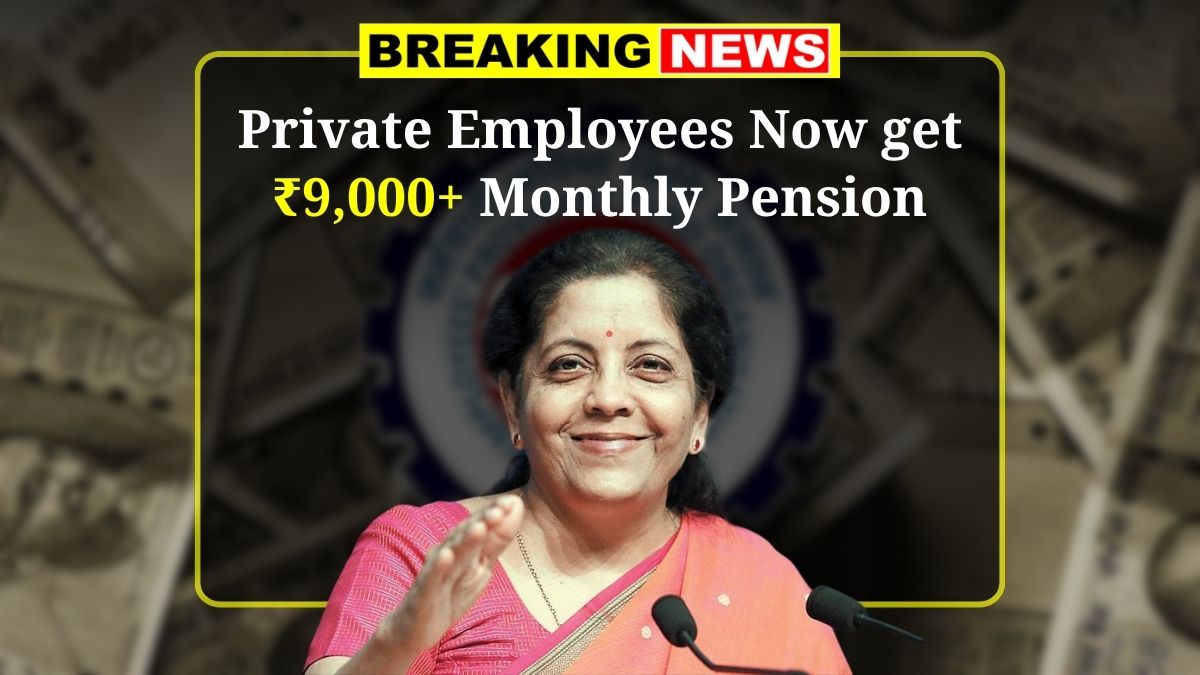EPFO New Update – Here’s some great news for private-sector employees across India! The Employees’ Provident Fund Organisation (EPFO) has come up with a major update that could change the way private workers retire. Thanks to a recent change in the pension scheme rules, private employees might now be eligible to receive a monthly pension of over ₹9,000 — something that was earlier thought to be possible only for government workers. This new move is a big step towards giving the private workforce a more secure and dignified retirement.
What Is This ₹9,000+ Monthly Pension All About?
EPFO has made changes in the Employees’ Pension Scheme (EPS), making it possible for eligible private employees to receive a much higher pension than before. Earlier, the pension used to be calculated based on a capped salary of ₹15,000 per month, which meant even long-term contributors ended up with low monthly pensions, often less than ₹3,000. But now, as per the Supreme Court’s 2022 ruling, contributions can be made based on your actual basic salary — not just the capped limit — and this opens the door to much higher monthly pensions.
How Does the New Pension Calculation Work?
Now, with this higher pension plan, your monthly pension after retirement could go well beyond ₹9,000 if you’ve contributed on your full salary and worked long enough. The updated formula used to calculate pension is: (Pensionable Salary × Pensionable Service) ÷ 70. This means, the more you earn and the longer you’ve contributed, the better your monthly pension.
For instance, if your basic salary is ₹25,000 and you’ve worked for 30 years, your pension could be around ₹10,714 per month. With a salary of ₹30,000 and 28 years of service, it could go up to ₹12,000. Some cases even show pensions going above ₹15,000! Of course, these are estimates and actual amounts may vary based on your contribution history and other factors like service breaks.
Who Is Eligible for This Higher Pension?
To be eligible for this higher pension benefit, you need to meet a few important conditions. You should have been an EPF member before September 1, 2014. You must have contributed based on your full actual salary, not just the ₹15,000 cap. There also needs to be a joint application submitted by you and your employer choosing to opt for this higher pension contribution. Also, you’ll need to deposit any pending or backdated pension contributions if required. Make sure your UAN is linked with Aadhaar and all your KYC details are verified in the EPFO system.
Documents Needed to Apply
Applying for this higher pension option involves a few necessary documents. These include the joint option form with your employer, your salary slips as proof of your contributions, your UAN, Aadhaar, PAN card, and a copy of your bank passbook or a cancelled cheque to link your pension account. You’ll also need confirmation from your employer and receipts if you’re paying any back dues.
Why You Should Consider Opting for Higher EPS Contribution
There are many benefits to opting for the higher EPS contribution. First and foremost, your monthly pension can increase significantly — potentially more than ₹9,000. You and your spouse will get a lifelong pension after retirement, which brings you closer to the kind of retirement security government employees enjoy. This not only helps you stay financially independent in old age but also ensures that your spouse continues to receive pension benefits in case something happens to you.
How to Apply Online for the Higher Pension
EPFO has made it easy to apply for this scheme online. Just go to https://www.epfindia.gov.in, find the “Pension on Higher Wages” option, and log in with your UAN and password. Upload all required documents, and wait for the verification from your employer and EPFO. If backdated contributions are required, you’ll be notified to make the payment. Once everything is approved, your pension will be recalculated accordingly.
Things to Keep in Mind
Of course, there are some challenges to be aware of. You may have to pay a large amount in backdated pension contributions — sometimes running into lakhs. The approval process can also be time-consuming and may involve follow-ups with your employer. Full documentation and legal compliance are essential, and in some cases, employers might delay their part of the process. So, patience and planning are important if you’re opting for this.
Old vs New: What’s the Real Difference?
When you compare the older pension system with this upgraded one, the difference is clear. While the old pension was calculated on a small salary base and offered limited benefits, the new plan promises a monthly pension between ₹9,000 to ₹15,000 or more, depending on your case. Plus, it offers more generous and secure post-retirement support for both you and your family.
The EPFO’s new pension reform is a big step toward making retirement more secure for private-sector employees. Though it requires some effort, documentation, and possibly large back payments, the benefits of a higher lifelong pension are well worth the process. If you qualify and plan smartly, this could be your key to a peaceful and financially independent retirement.
Disclaimer
The information in this article is based on current EPFO updates and publicly available guidelines. Pension eligibility and amounts depend on individual salary, service period, and compliance with EPFO rules. Readers are advised to visit the official EPFO website or consult their HR department for the most accurate and up-to-date information before taking action.




